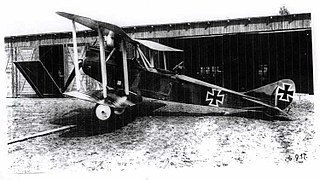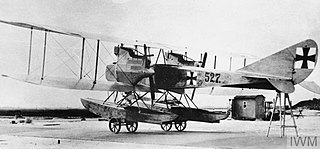
Friedrichshafen FF.33 was a German single-engined reconnaissance three-bay wing structure biplane, using twin floats, designed by Flugzeugbau Friedrichshafen in 1914 for the Marine-Fliegerabteilung aviation forces of the Kaiserliche Marine.

The Rumpler 6B was a German single-engine floatplane fighter with a biplane wing structure, designed and built by Rumpler Flugzeugwerke, in Berlin Johannisthal and introduced in 1916.

The Albatros J.II was a German single-engine, single-seat, biplane ground-attack aircraft of World War I.

The Hansa-Brandenburg W.12 was a German biplane fighter floatplane of World War I. Ernst Heinkel's KDW was redesigned, with a rear cockpit, reshaped tailfin, and rudder.
The Friedrichshafen FF.43 was a German single-seat floatplane fighter of the 1910s produced by Flugzeugbau Friedrichshafen.

The Friedrichshafen FF.48 was a German two-seat floatplane fighter of the 1910s produced by Flugzeugbau Friedrichshafen.

The Rumpler C.IV was a German single-engine, two-seat reconnaissance biplane. It was a development of C.III with different tail surfaces and using a Mercedes D.IVa engine in place of the C.III's Benz Bz.IV. The Rumpler 6B 2 was a single-seat floatplane fighter variant with a 120 kW (160 hp) Mercedes D.III engine built for the Kaiserliche Marine.

The Hansa-Brandenburg CC was a single-seat German fighter flying boat of World War I. It was used by both the Kaiserliche Marine and the Austro-Hungarian Navy.

The Hansa-Brandenburg W.11 was a fighter floatplane built in Germany in 1917 as a more powerful version of the KDW. Similar in general configuration to its predecessor, the W.11 shared the same unusual interplane strut arrangement, and featured fins above and below the fuselage. Only three examples were built.

The Hansa Brandenburg W.27 and W.32 were prototype fighter floatplanes developed in parallel in Germany during World War I. They were developments of and intended replacements for the W.12 then in service and differed from each other principally in the choice of powerplant, the W.27 with a Benz Bz.IIIb and the W.32 with the same Mercedes D.III that the original W.12 used.

The LFG Roland D.I was a fighter aircraft produced in Germany during World War I. It was a single-seat aircraft based originally on the Roland C.II two-seat reconnaissance type. It shared its predecessor's unusual design feature of having a deep fuselage that completely filled the interplane gap, but in comparison, the fuselage was much sleeker. While the C.II's appearance had earned the Walfisch ("Whale"), the D.I became known as the Haifisch ("Shark"). The I-struts that had been used to brace the C.II's wing were replaced by more conventional struts. Other changes to the wing included the removal of stagger from the design and the introduction of slight sweepback.

The Albatros W.3, company designation VT, was a biplane torpedo bomber floatplane prototype, built for the Imperial German Navy during the First World War. Only one was built.

The Zeppelin-Lindau CS.I was a German single-engined reconnaissance seaplane with a low-wing monoplane layout.
The LVG C.VIII was a prototype reconnaissance aircraft built in Germany during World War I.
The Märkische D.I was a prototype single-seat fighter biplane built in the last months of World War I.

The Hansa-Brandenburg W.16 was a floatplane fighter built in Germany during World War I for the Imperial German Navy.
Hansa-Brandenburg W.34 was a prototype German two-seat, single-engined floatplane, which had been designed by Hansa und Brandenburgische Flugzeugwerke during World War I.

The Hansa-Brandenburg W.18 was a single-seat German fighter flying boat of World War I. It was used by both the Kaiserliche Marine and the Austro-Hungarian Navy.

The Hansa-Brandenburg W.25 was a German floatplane fighter of the World War I era, designed and built by Hansa-Brandenburg.

The Friedrichshafen FF.63 was a German experimental floatplane produced by Flugzeugbau Friedrichshafen.
















